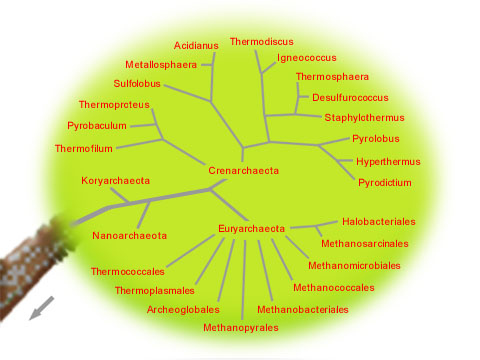Domain Archaea |
 |
The Archaea are a newly discoverd domain
of life on earth, originally thought to be a subset of Bacteria. Archaea
are microscopic, single-celled organisms characterized by the lack of
a membrane-bound nucleus and membrane-bound organelles. Another defining physiological characteristic of archaea is their ability to live in extreme conditions. They are often called extremophiles and unlike the bacteria and eukarya depend on either high salt, high or low temperature, high pressure, or high or low pH. Some believe the Archaea are ancient, since they live in harsh environments that resemble conditions existing when the earth was young. (The hyperthermophiles represent a living example of some of Earth's earliest organisms, located at the base of the Archaea.) The Archaea possess unique membrane lipids, which are ether-linked glycerol derivatives of 20 or 40 carbon branched lipids. The lipids' unsaturations are generally conjugated (as opposed to the unconjugation found in Bacteria and Eukaryota). These unusual properties of Crenarchaeota have attracted the attention
of a wide range of scientists, including evolutionary biologists, exobiologists
and biotechnology companies. The extreme conditions under which Crenarchaeota
live today may be similar to those which existed on the early Earth
at the time that life first arose. This, together with information about
their geneology, suggests that these organisms may be much like the
earliest lifeforms on earth. Photographs of some regions of the surface
of Mars suggest that large hot spring systems, perhaps containing microbial
life, may have once existed there. As a result, NASA exobiologists may
study these features for chemical and fossil remnants of organisms resembling
Crenarchaeota. |